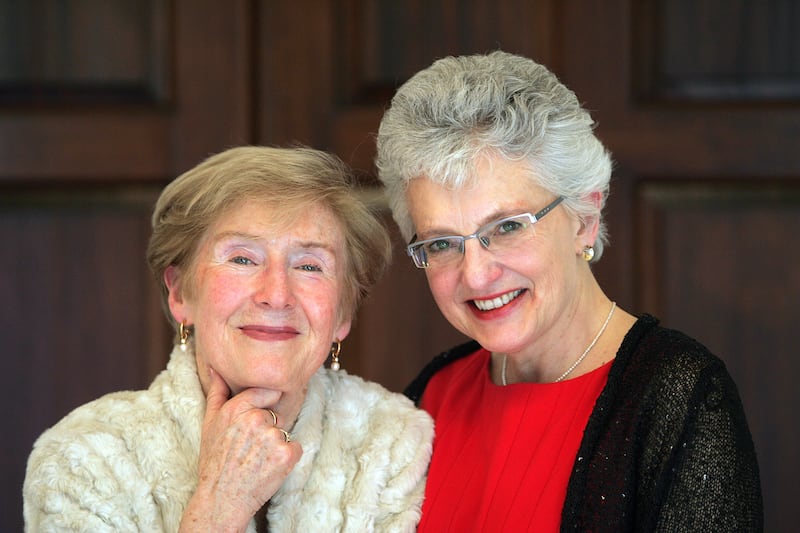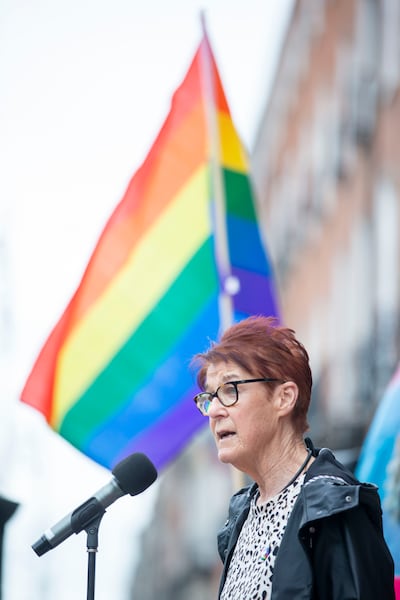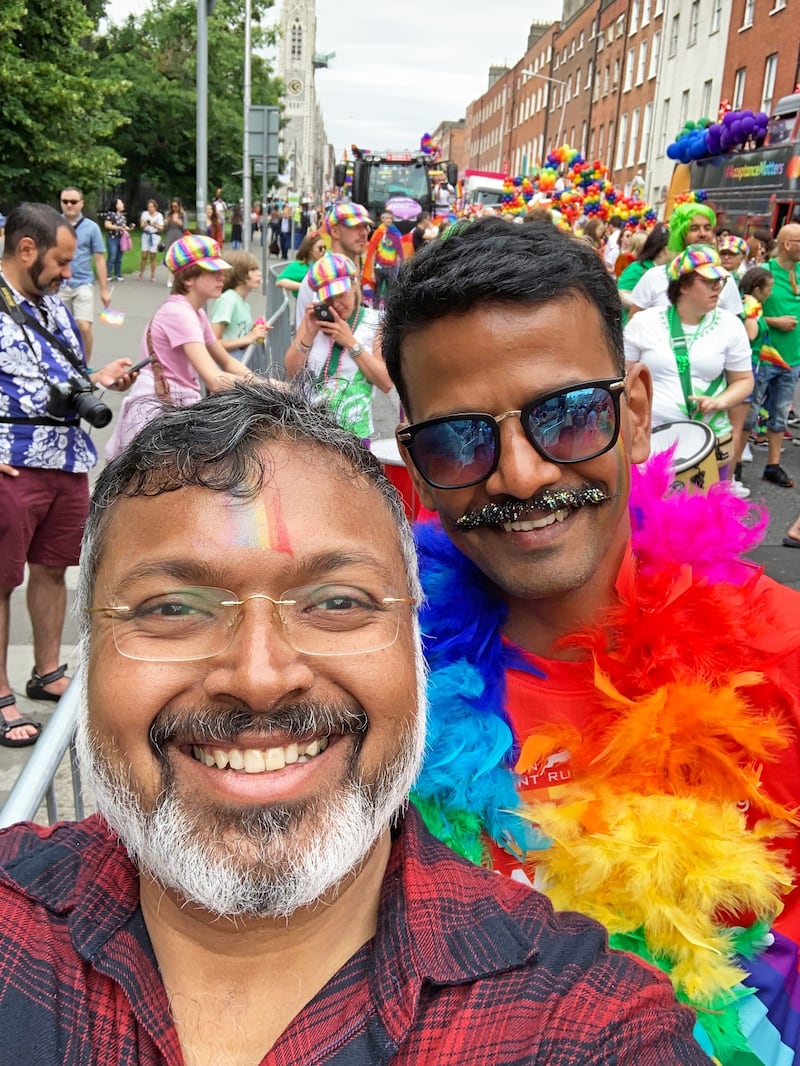‘It was a very happy experience’
Katherine Zappone, former minister

My first Pride was in 2003 after Ann Louise, my late spouse, and I got married and as we were preparing to take our case to the High Court to have our marriage in Canada recognised in Ireland.
It was great fun and we wore our wedding dresses. I got mine at a street fair in France the summer before and Ann Louise’s was a simple cotton dress. We also put on bands that said “just married” and everyone was delighted with us and gave us a lot of support. It was a very happy experience.
The next Pride in my memory is June 2015 just after Marriage Equality. Of course, we were all ecstatic. When you win you really need to have a big party because it is such a struggle to win and a lot of people don’t make it over the line. Ann Louise wasn’t well at that point. So there was a great joy but a profound grief too.
After that, my memory takes me to the first one I went to after Ann Louise died in 2017. She died on June 15th and I just felt I really should go anyway. My youngest brother, who’s also gay, came to support me.
I went to World Pride in New York in 2019 and two things were striking about that. As we moved through the streets on the Irish float, a few years after Marriage Equality, everyone went wild for us. But the other thing was that some of the Irish gay people in New York that year decided to honour the older members of our community through posters.
They came up to me and showed me one with Ann Louise’s face on it. She was only dead a couple of years. Her name and a beautiful picture was on it, and they were going to bring it through the crowd, and I thought, “Oh my God”. That took my breath away.
‘Families came up looking for pictures’
Miss Roots and Miss Taken, drag queen duo hosting comedy and cabaret
Miss Roots: One of my favourite years of Pride was in lockdown in 2020. We put on a live fundraiser for LGBT charities. Because we weren’t in front of the masses, it was the first time we got to experience Pride the way other people do. It’s probably the most unique and it’ll never happen again so we’ll always remember it.
But our first Pride in 2017 was together as drag queens, so we’ve never experienced Pride not as drag queens or not together. We were all still buzzing from Marriage Equality and it kind of felt like gay mecca.
Families wanted to take pictures with us, which felt so special because you know that at Pride they’ve made the effort to bring their children and they’re being allies. We were the first drag queens to arrive early in the morning and we were just hounded by the press. We thought, “Oh my God, this is what Pride is like, everyone wants to see us”.
Miss Taken: It was such a thrill because drag queens are historically always the butt of the joke, yet so many families came up looking for pictures and we were on the news. That year, there was a real sense of accomplishment and celebration, and now we’re going back to those roots of Pride as protest.
If Pride was a mature cheddar, it’s just getting better with age. Last Pride in particular, in 2022, we were DJing in Wigwam and the place was packed, everyone was having a good time and they even extended our set. It was just quintessential Pride. Memories like that really stand out.
‘Myself and six other LGBT+ Travellers made a home-made flag’
Oein de Bhardúin, Traveller Cultural Collections Officer, National Museum of Ireland
My first Pride was when I was 16 in Galway. I grew up in Tuam and I got a bus up to it. It was a tiny Pride. I didn’t walk in it, I just stayed in a certain corner and watched so I could feel I was part of it.
That was the turn of the century. I remember coming back and feeling it was very important, but I made it bigger in my head and a thing of risk rather than about these people who were happy and joyful but also standing against discrimination. Now I know these things can go together.
My first Dublin Pride was in 2006, when myself and six other LGBT+ Travellers made a home-made flag we stitched together. There were other people who didn’t feel comfortable coming, so we got their buttons and sewed them on to the flag.
It’s still difficult to get LGBT+ Travellers to go. When we talk about Pride, we make an assumption these spaces are free and open to all of us, including Travellers, but that’s not always true. I’ve had people in LGBT+ circles be very unkind to me because I’m a Traveller.
I encourage people to come to Pride every year, whether they’re LGBT+ themselves or allies, because it’s one of the few times every year we feel people are excited to see Travellers. It’s very dear to my heart.
‘It was very exciting for me to see queer people out in public’
Ruadhán Ó Críodáin, executive director of Shoutout

My first Pride was in Dublin when I was a teenager in 2007. I wasn’t out yet but I was thinking of building up the courage to do it and suggested to my friends that we go into town and take a look. I was really overwhelmed. I thought it was amazing but I was too scared to stay around for long. It was very exciting for me to see queer people out in public for the first time.
In 2014 I went to Pride with Shoutout as a volunteer while I was in college. Back then Pride was still on the original route. Everyone was talking about Marriage Equality. It was the only thing on the agenda. Not trans rights or parents rights, which was fair enough at that time. It was exciting. It felt like it was going to happen.
Pride hits a bit deeper this year because it’ll be my first Pride out as a trans man. Last year it was so amazing to see so many trans people in public celebrating.
Pride definitely needs to return to more of its protest roots. Trans pride is a really good example of that, which is by the community and for a community.
Marching at Pride with Shoutout volunteers is really special, and Pride is one of the only events all year where families and people who are not out get to be there, and it’s still a huge day for them.
‘I was aware I was saying something very important to the world’
Ailbhe Smyth, activist

At my first Pride in the late 1980s, I got all dressed up in a white suit and I remember clearly walking down East Essex Street with a group of women and this feeling of it being absolutely wonderful to be part of Pride, and of being delighted to be there out on the streets. But at the same time I was aware I was saying something very important to the world which was: “Look at me. Look me in the eye, and don’t pretend I don’t exist.”
Decriminalisation was really important in 1993, but that was about male homosexuality and there was still a huge silence around women. People preferred for me not to tell them I was a lesbian, and I had to insist on telling people for about a decade.
We were very brave, there’s no doubt about it. And we had to be, because we were up against it. The world is different now, but it’s still not that easy for young people today.
Now it is accepted that we exist and there is a tendency to see Pride as more of a celebration, and that protest dimension is much less front and centre. However, I think that sense of challenge is still really important because all is not well for LGBT+ people, particularly when we think about trans people.
‘I never saw diversity until I went to Pride in Dublin’
Debbie O’Rourke, youth worker with Pride of the Deise in Waterford
I didn’t go to my first Pride until I was in my 20s. There were no local Prides when I grew up in rural Kildare, which meant I never saw diversity until I went to Pride in Dublin.
When I moved to Waterford in 2019 a group of us came together to set up Pride of the Deise. I’ve been the youth committee coordinator since I came on board, facilitating young people aged 10-24 to set up events.
The first year we ran it was 2020. All plans were working towards an in-person event but obviously we had to change that due to Covid. It was totally online but it was brilliant.
A moment that stands out for me was at our first in-person Pride of the Deise march in 2022. It’s hard not to mention the look on young people’s faces seeing this huge group of people celebrating them. I remember a man along the quays was shaking his head at us – but that’s what Pride is about – being visible unapologetically and standing up to that.
‘People of colour made up such a small minority at Pride’
Pradeep Mahadeshwar, founder of Queer Asian Pride

I went to Pride with my partner at the time in 2012. I had been to Pride in London before, but this was my first Pride in Ireland. I was very new to Ireland then and I was struggling to make money so I didn’t have any fancy clothes or anything. But I remember feeling so emotional and happy, and the freedom of it. It was a special time.
Later, I realised people of colour made up such a small minority at Pride. That started to make it feel very isolating for me. I remember one year, I met a guy at Pride who was talking to me and asked me if I was okay and I just started crying because I felt so lonely.
But that gave me the power to start talking about it and writing about it. Being queer comes in so many different ways, shapes and sizes. Now I’ve set up Queer Asian Pride. This is the first year we’ll have an event for it. It will be a small start but it’s exciting. We’re putting on a photographic exhibition. It’s not only for queer Asians but for everyone under the LGBT umbrella and anyone who’s an ally too.
‘It’s more important than ever that Pride is a protest’
Ranae von Meding, LGBT+ parents rights activist
I went to my first Pride the year after my wife and I started dating, in 2009. All of the Prides over the earlier years tend to be a blur of celebration and being visible.
I know Pride has always been a protest but in those earlier years I didn’t realise how much there was left to do. In the last few months the rise in hate crimes and transphobia makes it feel like we’re almost going backwards, and that it’s more important than ever that Pride is a protest. It’s not enough to just slap a rainbow on it and say “love is love”.
Equality for Children formed in 2019 and we have made a small bit of progress in that area but there’s so much left to do for LGBT parental rights.
I always love to see when things are made more accessible and more family friendly. That’s definitely been happening in the last couple of years, with the parade ending in Merrion Square, which is a lovely venue for families. I hope that continues and that people of all ages can partake. Traditionally, Pride can be a bit of a wild party, which is really great, but it’s also great for the entire family to be able to come.
‘I’m fortunate I was able to have that experience as a teenager’
Luke Faulkner, photographer and filmmaker
This will be my 10th year attending Pride. I first went when I was 17. My older brother is gay, he was out at the time and my mam and sister went to be with him. But I wasn’t ready to come out yet and said I was just going to support him.
We went to the parade and walked the whole route. It was one of the first times I had been in a space like that because I hadn’t yet been in a gay club or anything. It was very liberating. I’m fortunate I was able to have that experience as a teenager. That’s still one of my favourite Prides.
I’ve spent every Pride since with my friend Sophia. After Marriage Equality, it felt like everything was moving in the right direction. It was the start of everything becoming bigger and more visible, which is good in some ways. But I’ve always been very critical of a lot of the corporate influence at Pride. After 2015 it was suddenly like: “Where did Google and so on come from?” But on the other hand, it’s important to have it because there’s always going to be some LGBT teenager somewhere who needs to see that visibility.












